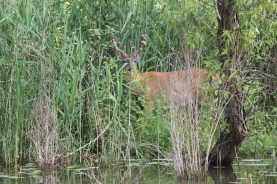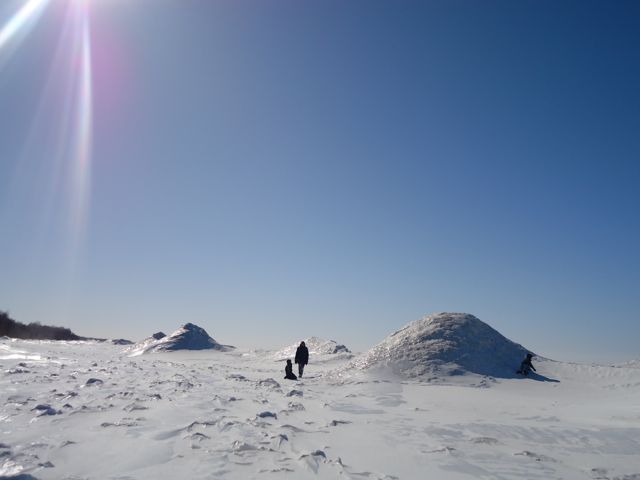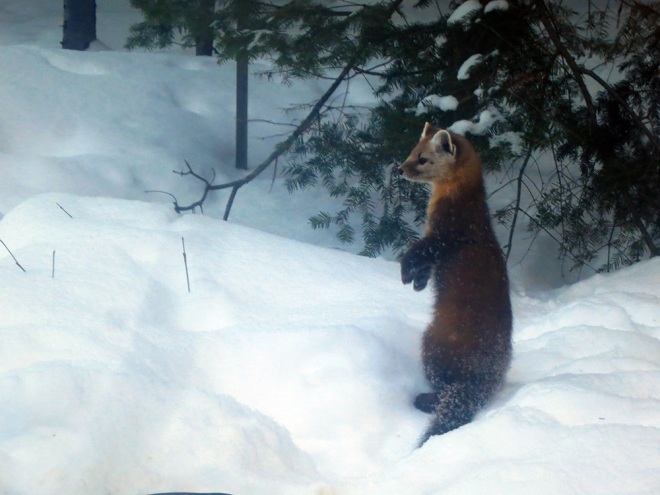I have been feeling a fire lighting in my belly again, or perhaps simply an ember which will grow into a fire with tending. Last year at this time someone told me that early February is the pre-ovulation phase of the earth. The world looks and feels like winter, but there are hints of life starting to stir below the surface: the sap is beginning to move, there is quickening underground, there is a rumour in the air of the fertility and abundance to come.
Last year, on the coldest day in February, when the temperature had dropped into the -20s (Celsius) and heavy snow covered the ground, I stood at the bottom of a Toronto ravine and heard the courting song of the cardinal. It was my first sign of spring, and now I know it will come again soon.
Last weekend, I trailed two moose with a group in Algonquin Park: huge frozen lakes, tall trees, deep snow, the crunch of snowshoes, hand signals and hushed laughter; an hour sitting and watching one female moose closely across a small stream as it relaxed into our presence, with her calf moving in silhouette on a slope in the distance. It was my only opportunity for real tracking this winter, and it was like a blast of warmth to feel the return of the joyful, boisterous, alive, and profoundly connecting energy that came with it.
The new moon, the lunar new year, the lengthening days, Imbolc – I am open to tapping whatever influences are available, real or metaphorical. One way or another, I have felt myself emerging from winter’s dark, at first gradually, and then with a jolt.
As I stumble through my internal swamp, I see in a moment of clarity that meaning is something I will need to create, that it won’t offer itself up to me on one of the heavy brown plates passed down to me with my mother-in-law’s wedding china. I will need to find the will to mold it out of the clay of my life. It will have to be a choice.
I can pause, I can rest, I can mourn; but every day, I need to make the choice to re-engage with the world, both as it is and as I wish it to be.
I am sometimes tripped up by the cultural pressure to be happy. And this is a hard one to unravel – I am grateful for everything that the Earth provides; I feel awe and wonder and love and the electricity of being alive. I am often deeply joyful. But not to see the grief that is also always present in the world, to brush it aside, that seems to me a profound dishonouring of the fullness of living experience. Being fully present both to celebration and to grief – that is part of what it means to be a spiritually healthy human being. It means being able to hold that tension.
Grief is the awareness that our time here is short, that we are all broken in some way, that there is great pain in the world we live in, that so much has been destroyed, that we are clinging to a life raft and may never make it to shore. But in that grief, we can also see the beauty of the everyday, because in this moment we are alive.
Gratitude and grief are two sides of the same coin. Here we are: so much has been lost and continues to be, and we are committed to a lifetime of mourning. But here we are: we are alive, we have the fierceness and tenderness of love, we have sunshine and water to drink and the crunch of the snow under our feet and our hearts which beat day and night without stopping. We can laugh. We can reach for each other.
I have been thinking about how in the first half of life we gather and accumulate: things, accomplishments, energy, love, people, our own gifts. And for a long time we might feel that there will always be more. But, if it hasn’t happened earlier, there is a moment at midlife when we will look around us and sharply catch our breath, because we see that every mortal thing will one day be taken away. And it’s like that moment in late August, when we become of aware of the setting sun while still eating dinner under the trees, and feel that bittersweet turn between summer and fall, and anticipate the harshness of winter.
And now, it’s February, the month of the Hunger Moon. We’ve made it through the darkest nights, but there is still some danger. In an earlier time, in this northern climate, we would now be living at the limit of our stored resources and our body’s reserves. We would need to look out for ourselves and for each other. Perhaps we would start to feel the quickening in the air and in our bodies, but we would need community and compassion and resilience and faith to believe that the world would come back to life for us once more.
After I wrote that it had been a hard January, some people said “I know exactly what you mean,” and a few people said they were sorry to hear it. But I don’t think there’s a need to be sorry, only to be present. The darkness doesn’t feel good, but it feels necessary. It is part of being human. It’s not the last time it will come. I can come through darkness with a renewed sense of strength and purpose; a renewed sense of what is possible and what isn’t; a renewed sense of what to hold on to and what to let go of in my life.
And I have kept my commitment, over the winter months, to be gentle with myself.
Now, I am grateful for the lengthening days, I am grateful for newfound energy, I am grateful for the physical and spiritual nourishment around me, I am grateful for compassion, I am grateful to see others emerging from the dark: I am grateful for the promise of spring.

Pema Chödrön on self-compassion and compassion towards others. Over the past few weeks I have started working on a daily Book of Hours – an illustrated book compiling quotes, poetry, meditations, and other wisdom – inspired by a workshop with my friend Rozanne Lopez.
















